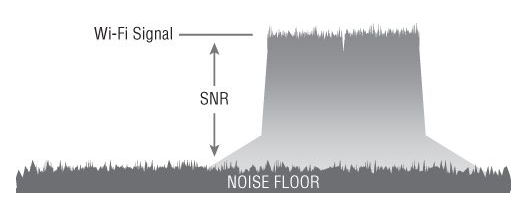SNR
. . . .
Signal to Noise Ratio
- SNR is the difference in decibels between the received signal and the background noise level (noise floor).
- For example, if a radio receives a signal of –85 dBm and the noise floor is measured at –100 dBm, the difference between the received signal and the background noise is 15 dB. The SNR is 15 dB.
- Data transmissions can become corrupted with a very low SNR.
- If the amplitude of the noise floor is too close to the amplitude of the received signal, data corruption will likely occur and result in layer 2 retransmissions.
- The retransmissions will negatively affect both throughput and latency.
- An SNR of 25 dB or greater is considered good signal quality.
- An SNR of 10 dB or lower is considered very poor signal quality.
Noise Floor
The noise floor is the ambient or background level of radio energy on a specific channel.
This background energy can include:
Anything electromagnetic has the potential of raising the amplitude of the noise floor on a specific channel.
The noise floor is the ambient or background level of radio energy on a specific channel.
This background energy can include:
- Modulated or encoded bits from nearby 802.11 transmitting radios
- Unmodulated energy coming from non-802.11 devices such as
- Microwave ovens
- Bluetooth devices
- Portable telephones
Anything electromagnetic has the potential of raising the amplitude of the noise floor on a specific channel.
Reference:
Coleman, David D.,Westcott, David A. CWNA: Certified Wireless Network Administrator Official Study Guide: Exam CWNA-106 Wiley.
Coleman, David D.,Westcott, David A. CWNA: Certified Wireless Network Administrator Official Study Guide: Exam CWNA-106 Wiley.
|
|

